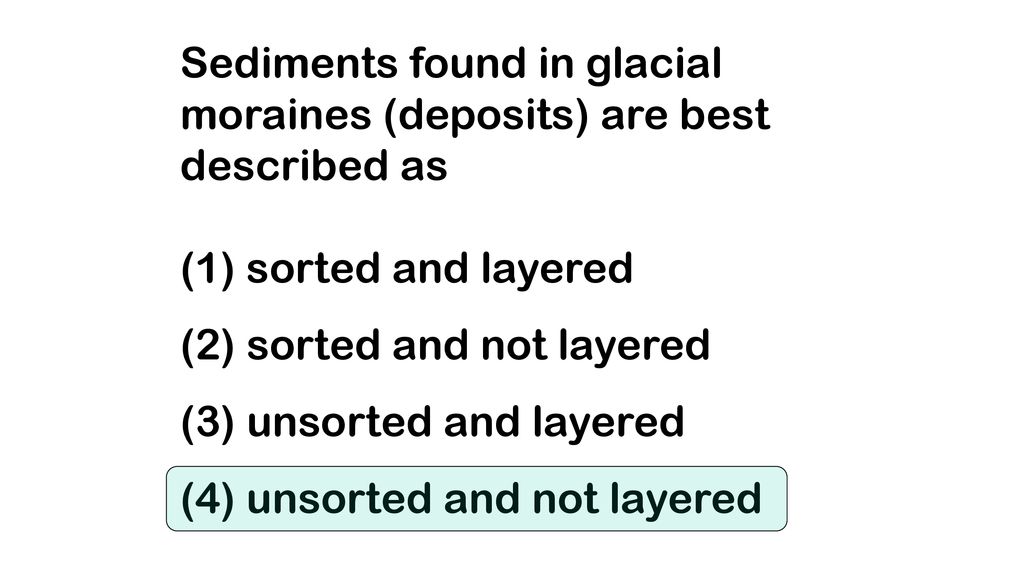Sediments Found in Glacial Moraines Are Best Described as
The end moraine that represents the farthest advance of the glacier is a terminal moraine. Glacier Erosion and Deposition DRAFT.

Moraine Formation Antarcticglaciers Org
When a glacier melts the ground moraine underneath is exposed.

. Sorted and deposited by ice b. Which size sediment still can be carried. _____ is the unsorted material that is deposited directly by ice.
Ground moraines are the most common type of moraine and can be found on every continent. A glacial deposit is known as a moraine. 18The moraines are recognized as glacial deposits because they are composed of rock materials that are Agrooved bedrock near the top of Bear Mountain Bglacial soils in southern Connecticut Cglacial boulders at the bottom of Long Island Sound Dscratches on loose rock at the mouth of the Hudson River.
Shaded areas on the diagrams below show the part of New York State that was covered by glacial ice during the last ice age. Till that forms a fairly flat blanket over bedrock or older sediments is called ground moraine. The diagram below shows a glacial landscape feature forming over time from a melting block of ice.
Sediments found in glaciers moraines are best described as. 12What is the best evidence that a glacial erratic has been. A moraine may form a dam keeping back the glacial melt-water forming a.
Age of fossils found in the sediment. CIts composition is different from that of the bedrock under it. Sorted and deposited by meltwater c.
9th - 10th grade. Which rock material was most likely transported to its present location by a glacier. Reconstructing these settings or depositional environments is the ultimate goal of glacial.
Sediments found in glacial moraines are best described as 10Base your answer to the following question on the diagram below which shows four tubes containing 500 milliliters of sediment labeled A B C and D. Which two layers of sediments were probably deposited directly by glaciers. What glacial features results from deposition.
As glaciers move and retreat they push and drop rocks and sediments in a process known as glacial deposition. Where the ice-sheet. Till is deposited directly at the bottom of advancing ice or by the melting of stagnant ice.
Sand silt and clay only. An unsorted glacial sediment composed of materials ranging in size from boulders to clay and deposited directly by ice is called till. The ridge of sediments from X to Y can best be described as.
The sediments in layers A through F are included. Most sediments found on the floodplain shown in diagram A are likely to be. Which landform is produced at location E where the Mississippi River enters the Gulf of Mexico.
Unsorted and deposited by ice d. _____ are enormous boulders transported and deposited by glaciers often far from their source region. R indicates elongated hills.
A ground moraine is made of sediment that slowly builds up directly underneath a glacier by tiny streams or as the result of a glacier meeting hills and valleys in the natural landscape. Glacial sediments can be deposited or tectonically accreted in a range of different settings that may be defined by their geomorphology eg glaciolacustrine glaciofluvial and position relative to a body of ice eg subglacial englacial supraglacial ice-marginal and proglacial. Questions 21 through 23 refer to the following.
Learn about this glacial process and the interesting landforms that result from it including moraines erratics and drumlins in this lesson. The diagram below shows the edge of a continental glacier that is receding. Glaciers Leigh-Manuell - 4.
Supraglacial on top of the ice and englacial within the ice sediments that slide off the melting front of a stationary glacier can form a ridge of unsorted sediments called an end moraine. Unsorted and deposited by meltwater Packet. Glacial Deposition I have a little quiz for you.
Which area of the United States. A B and F B D and E C C and E D A and D 20 Sediments found in glacial moraines are best described as A sorted and not layered B unsorted and not layered C sorted and layered D unsorted and layered 2912 - 1 - Page 5. The best inference that can be made from these diagrams is that this glacial ice 1 was about 1 mile thick at New York City 3 moved more slowly than the glaciers of earlier ice ages.
A ridge of sediment in a terminal moraine can best be described as a. DIt appears to have been intensely metamorphosed. This glacial landscape feature is best identified as.
The term ice-marginal is also used for sediments which have been deposited in close proximity to the glacier as deduced for instance from the presence of tensional deformation features resulting from the melting of buried dead or stagnant ice. The main types of sediment in a glacial environment are described below. BIt is less than 25 centimeters in diameter.
20 Sediments found in glacial moraines are best described as A sorted and not layered B unsorted and not layered C sorted and layered D unsorted and layered. Diagrams A B and C represent three different river valleys. Up to 24 cash back 11Sediments found in glacial moraines are best described as AIt is located at a high elevation in a mountainous area.
What Is The Difference Between A Moraine And A Till Quora

Which Agent Of Erosion Created The U Shaped Valley And The Striations Found In The Flat Rock On Its Floor 1 Running Water 3 Glacial Ice 2 Mass Ppt Download
No comments for "Sediments Found in Glacial Moraines Are Best Described as"
Post a Comment